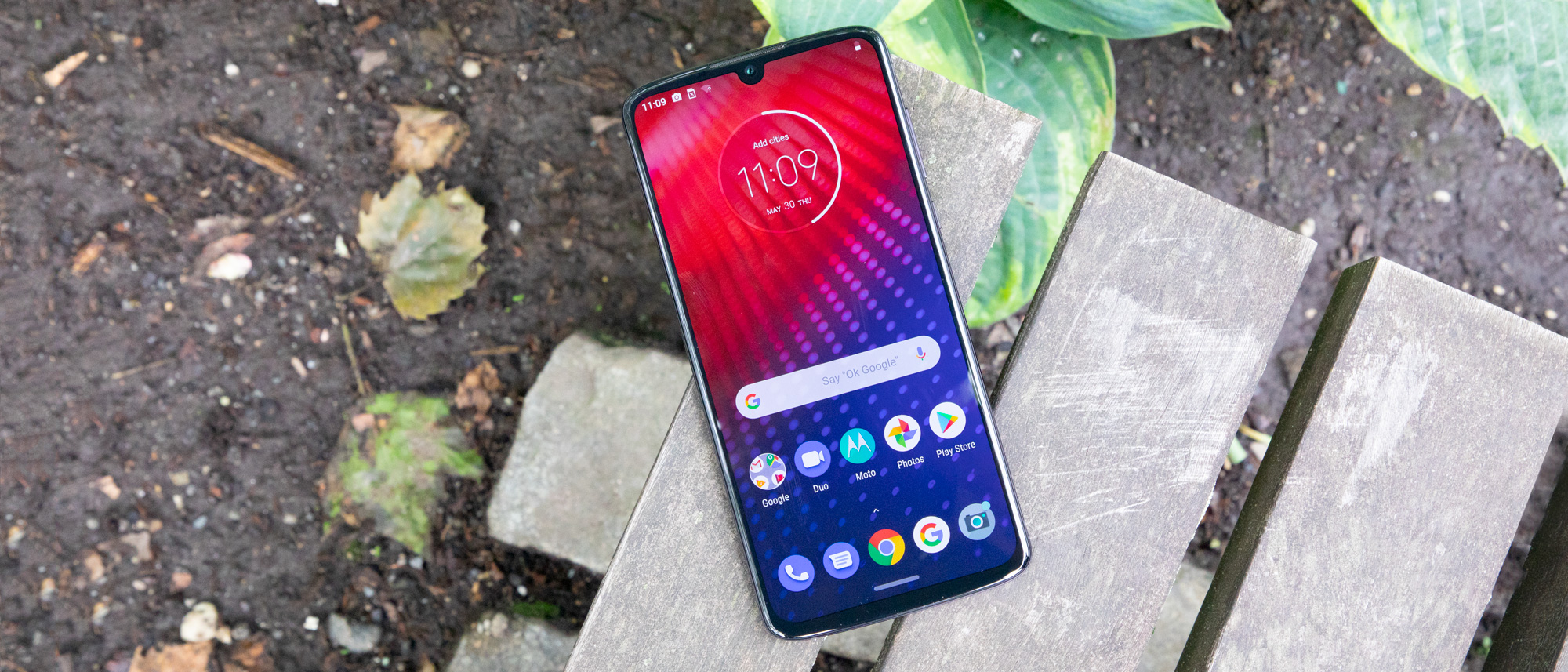TechRadar Verdict
The Moto Z4 drifts more solidly into midrange territory, which isn’t necessarily a bad thing with the latest middle-of-the-road Snapdragon chipset and higher-megapixel rear camera. But the rest of the phone’s design and features barely iterate over its predecessor. Only its compatibility with the 5G Moto Mod, making it the cheapest 2019-released phone to get 5G, make it stand out.
Pros
- +
Cheapest new 5G option
- +
Moto Mods..?
- +
Nearly stock Android Pie
Cons
- -
Opts for a midrange processor
- -
No groundbreaking innovations
- -
Night Vision frustratingly absent
Why you can trust TechRadar
2-minute review
The Moto Z4 is Motorola playing it safe, firmly planting their new 5G-upgradeable phone in the midrange market without the pretense of duking it out with the big flagship smartphones. Aside from a few new features and tolerable price, it’s largely an iterative upgrade to its predecessor.
In other words, don’t be surprised at the Moto Z4’s conventional phone design that’s also beholden to the Z line’s signature feature: Moto Mods. While those can be useful in broad (battery pack) or niche (Alexa speaker) settings, to be compatible, each new phone in the series must have an identical rear design, with pins at the bottom and a circular camera bump.
Heck, it’s had to keep the same size and shape from 2016, too, to keep the Mods from looking awkwardly larger or smaller than the phone.
True, the Z4 does improve on the Moto Z3, with a larger 6.4-inch OLED display spreading around a teardrop notch and an in-screen fingerprint scanner. These may not be cutting-edge features in 2019, but they’re still welcome additions to a midrange phone.
Other improvements can be counted on one hand: bumping up the rear camera from dual 12MP to a single 48MP lens (with software making up the depth difference), boosting the front-facing lens to 25MP, adding back in the headphone jack, and bumping up the battery capacity.
The other changes are more...settling the Moto Z4 into midrange territory, which had been the purview of the ‘Play’ versions of the Z-line (thus far, we haven’t heard anything about a Moto Z4 Play). While its predecessor packed a then-old Snapdragon 835 chip, the new handset opted for a just-released Snapdragon 675 featured in phones in a similar price range.The 4GB of RAM isn’t much to brag about, but it didn’t slow the phone down in our tests, either.
Skyrocketing prices of top-level handsets like the Samsung Galaxy S10 and iPhone XS makes the Z4 a value buy at half the cost of either of those - and is especially cheap if you want to be one of the first to hook up to 5G. With the 5G Moto Mod (sold separately), the Z4 becomes the second-cheapest 5G phone to access the blindingly-fast speeds of the next-gen networks, behind the world’s first 5G phone, the Moto Z3.
That alone sets the Z4 apart from other midrange phones, its raison d’etre: an affordable 5G handset. Otherwise, it struggles to distinguish itself from the real killer budget phone in the room - the camera-focused Google Pixel 3a - but it also faces fierce competition from older but better-specced midrange phones like the LG G7 or OnePlus 6T. It’s even hard to recommend over the budget Moto G7 released earlier in 2019 and our best cheap phone pick.
In summary, you wouldn’t be doing yourself a disservice picking up the Moto Z4, but there are other very competitive options in the market.
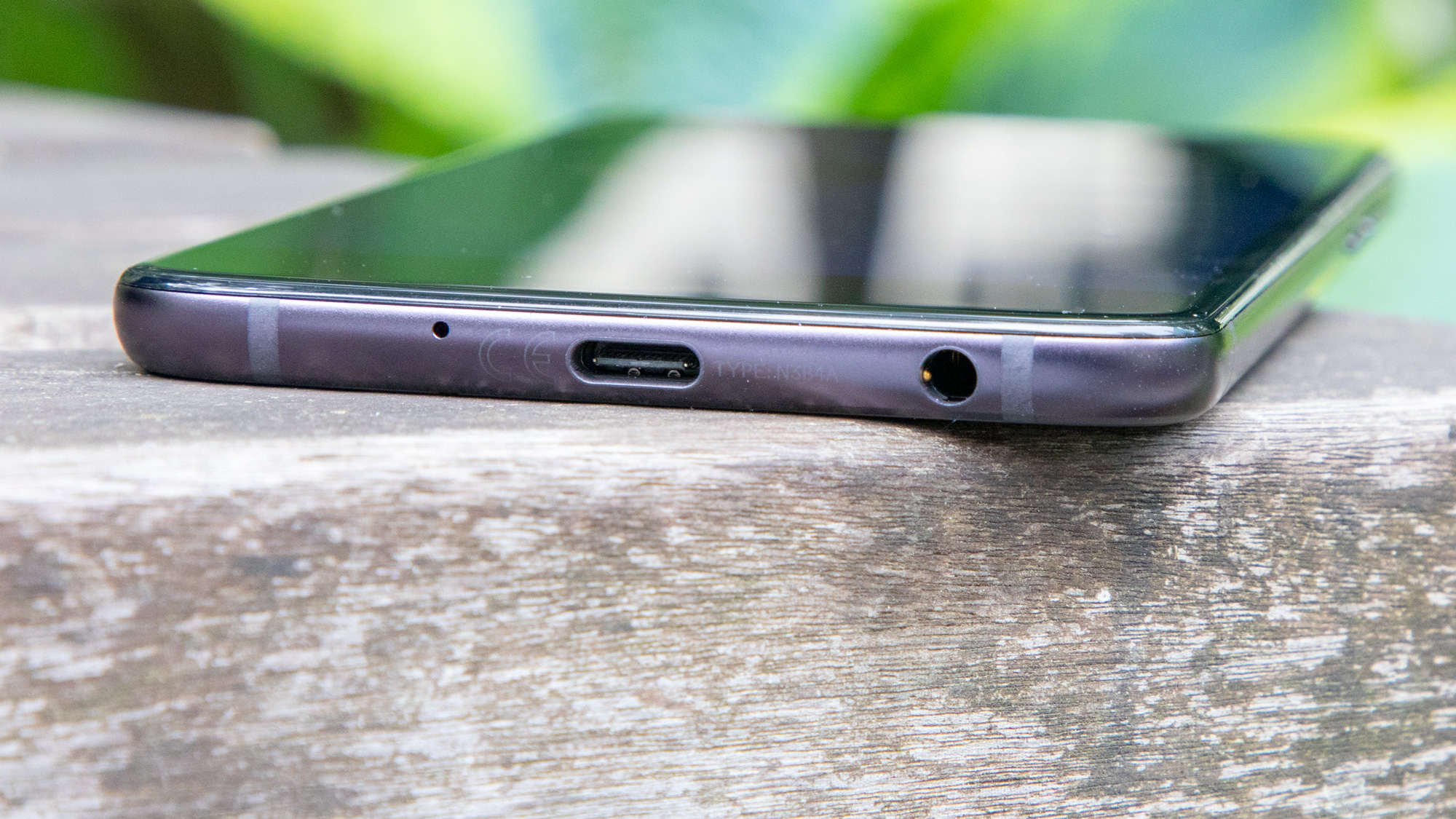
Price analysis
The Moto Z4 launched in the US on June 13, 2019, and thus far, it isn’t available in other regions. This matches the similarly restricted release of the Moto Z3 that preceded it, which was only sold through Verizon.
The Moto Z4 costs $499 either through Verizon or unlocked, and only comes in a single configuration: a respectable (and now industry-standard) 128GB of storage and 4GB of RAM.
Keep in mind that the Verizon version is the only one that works with the 5G Moto Mod (and comes in a dapper bright white color). The unlocked slate gray model won’t recognize the Mod, which makes sense, given that it only works with Verizon’s particular 5G network.
The 5G Moto Mod retails for $349 on Verizon’s site or in a Verizon store, but you can only pick one up while picking up a compatible phone (for now, only the Moto Z4 or Moto Z3) linked to one of the carrier’s Unlimited plans. Verizon has been known to bundle both the Mod and Moto Z4 for a discount.
Verizon’s lockdown of the Moto Z4 aside, the phone isn’t much more expensive than its predecessor was at launch, and we wouldn’t be surprised if it was discounted in the coming months, especially during Amazon Prime Day. If you buy the unlocked Moto Z4, you’ll get a 360-degree camera Moto Mod included for free.
5G at a discount
One of the big reasons to pick up a Moto Z4 is to pair it with a 5G Moto Mod add-on to hook up to Verizon’s next-gen 5G ‘Ultra Wideband’ network. (Remember, buy it through Verizon, as the unlocked Moto Z4 won’t work with the carrier’s network.)
It is, indeed, currently the cheapest way to enjoy 5G among newly-launched phones in 2019: the combined price ($499 Moto Z4 + $349 5G Moto Mod) of $849 is far more affordable than the $1,299, £1099 (around AU$1,850) base price of the Samsung Galaxy S10 5G, the only other current 5G-compatible option.
In any case, should you pick up a 5G Moto Mod and a Moto Z4, you’ll need to be on either qualifying Unlimited plan for Verizon - and bump that plan up with the 5G option, which costs $10 extra per month. That fee is waived if you just picked up a Moto Z4 (lucky you!).
Right now, Verizon’s 5G network is live in areas of only four cities: Minneapolis and Chicago, where it launched back in April, and Denver and Providence, which recently went live. The key word here is ‘areas’: Verizon’s 5G network runs on ‘millimeter wave’ (or mWave) frequencies, which promise blisteringly high speeds but cover a minimal amount of area. Head over to our Verizon 5G page to see the handful of neighborhoods in each city that have 5G coverage so far.
Also, keep in mind that you might not get as fast of speeds with the Moto Z4 - we haven’t tested the new model with the 5G Moto Mod, but when packed with the older Moto Z3, we encountered lower speeds (above 650 Mbps) than we saw with the Galaxy S10 5G (up to 1.4 Gbps) on Verizon’s Ultra Wideband network.
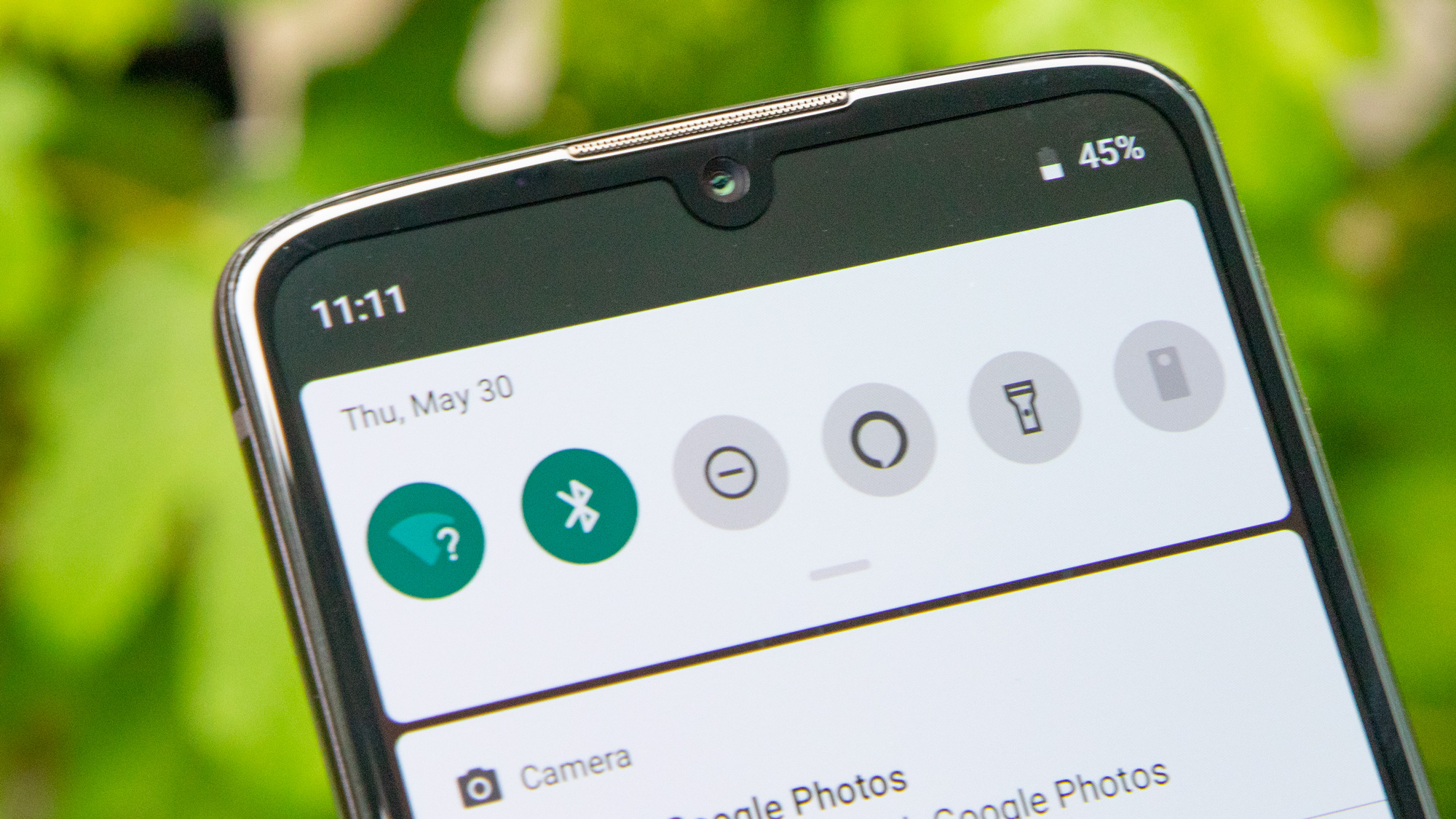
Display
One of the Moto Z4’s biggest upgrades over its predecessor lies in its 6.4-inch OLED screen. At long last, a top-line Motorola phone has abandoned the squared-off header and beefy chin in favor of a more traditional rounded edges and, yes, a notch.
Whether you tolerate the notch enough to enjoy the undeniably larger screen real-estate is a matter of taste. The previous Z-line phones remained among the stoic few to keep a screen unblemished by notches or punch-holes, but OEMs are pushing for ever-better screen-to-body ratios, and the thick headers on the Moto phones were starting to look dated.
Here’s what hasn’t changed: the 1080 x 2340 resolution remains Full HD+ and is spread out over an expanded screen real-estate But it’s technically no sharper - don’t expect multimedia to be as crisp as on QuadHD-touting flagship phones when looking at high-resolution content.
Good news: in our media tests - that is, streaming Netflix and HBO content - we didn’t find the display underperforming compared when we sat it next to the iPhone XS Max. It pulls the common midrange phone trick of pushing more vibrant colors to provide a wow factor, but not so egregiously as other handsets. What is noticeable is the odd formatting choices that will opt to black-out the header to avoid folding the media around the notch while running up to the curved footer edges.
The display has an in-screen fingerprint sensor, which was exciting when it debuted in Huawei and OnePlus phones last year but is becoming fairly standard today. It also operates noticeably slower than other in-display scanners - often taking one second, but sometimes up to a full two seconds to unlock the device. It’s at least accurate in the end, which we can’t say about all phones (like the Nokia 9 PureView’s erratic sensor).

Design
You’d be forgiven if you picked up the Moto Z4 and couldn’t tell it apart from its predecessors. The differences are subtle, and that’s not a complement: the phone’s design has changed very little since the original Moto Z.
The biggest changes have been in the display (this is the first Moto Z with a notch) because, as previously mentioned, the size and shape of the Z series needed to line up with the Moto Mods. Motorola last promised in 2016 that phones would support the Mods for three years, but it seems that’s been extended in 2019, for better or worse.
Because the phone must have the same rough size to fit Moto mods, in order to accommodate its bigger battery (3,600mAh vs. the Z3’s 3,000mAh) and returning headphone jack, the Z4 is thicker - up to 7.4mm from its predecessor’s 6.8mm. Admittedly, that’s not huge in the world of smartphones, but the Z-series needs to be thin...because Moto Mods are clamped to the back which, at best, double its girth. The bigger ones, like speakers and the projector Mod, plump it up even more.
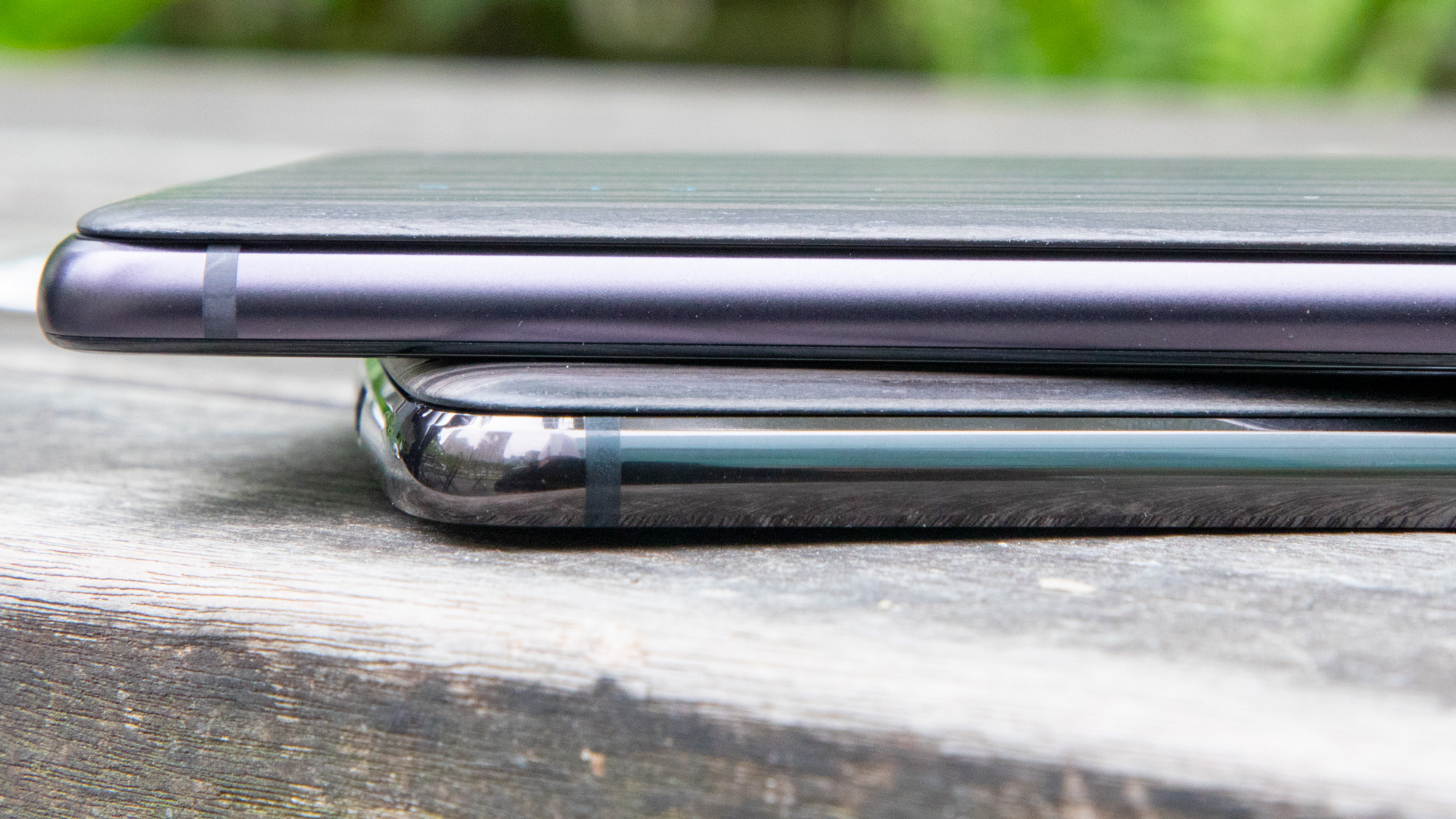
But the Z4 isn’t exactly the same shape as its predecessor - it’s actually a couple millimeters taller and a millimeter narrower. This means most Moto Mods now hang slightly over the edge instead of coming up flush against the side, which is both unsightly and could leave room for something to catch that gap and wedge apart the phone and Mod.
That aside, the phone is not without its advancements. The headphone jack is back (poking out the bottom, as all 3.5mm ports should), and the top phone grille has been minimized to a sleek strip above the front-facing camera. Now that the phone has an in-display fingerprint scanner, the sides are unblemished save for a wide volume rocker and textured lock button below it, both on the right.
While the Z4 follows its precursors with a glass front and rear sandwiching an aluminum middle, the rear is no longer glossy. Instead, Motorola opted for a matte or frosted look - which, in our opinion, is a little less classy but it doesn’t hold a single fingerprint. Unfortunately, it also scratched easily. Take that as you will.
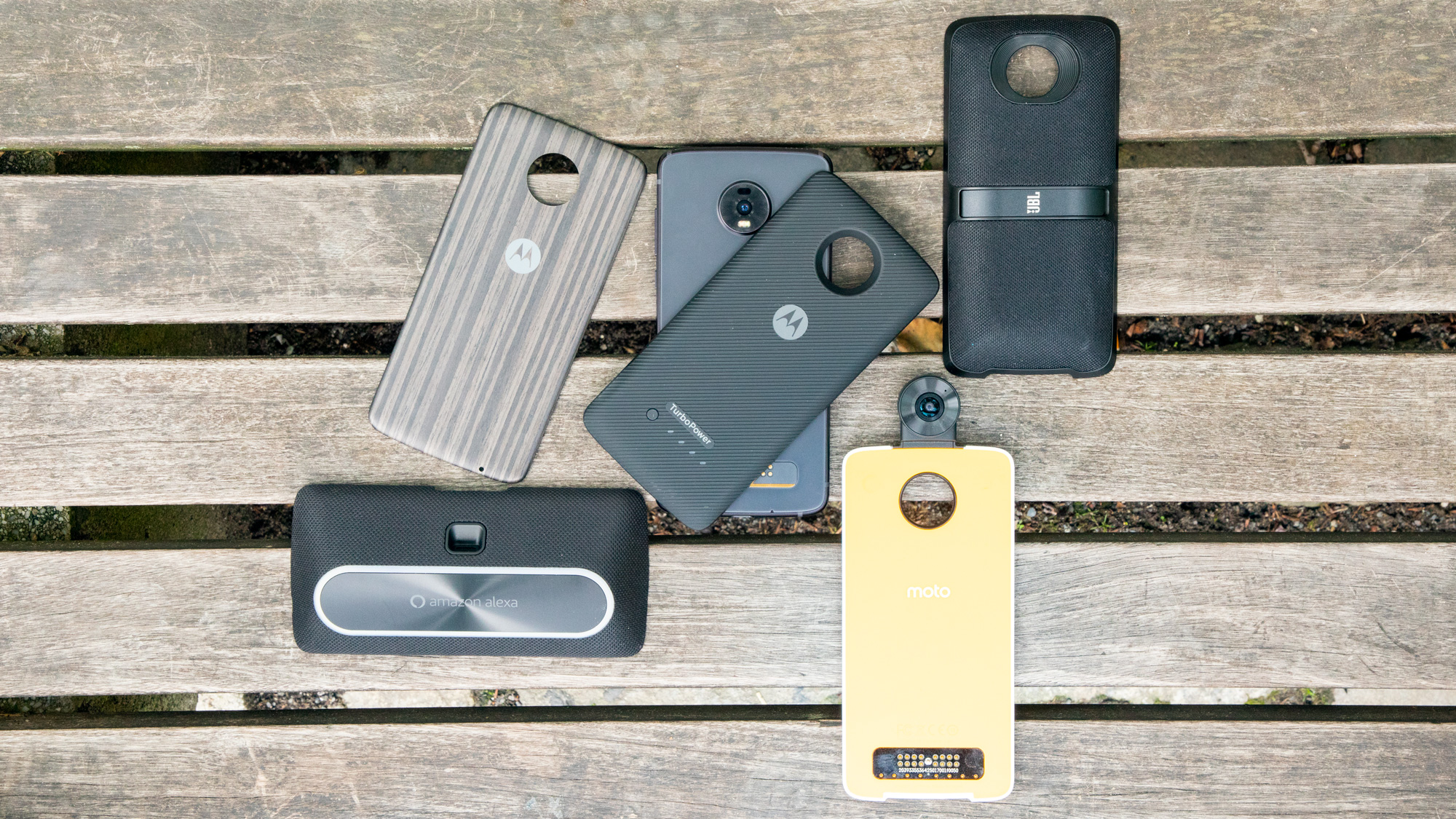
Moto Mods
Oh, the Moto Mods. On the one hand, it’s notable that Motorola has continued to support these add-ons with their latest highest-tier phones; on the other, not all are terribly useful, though they all have their conceivable purpose.
If you’re a 5G aficionado (and Verizon subscriber), you’ll be keen to pick up the $349 5G Moto Mod, which must be attached for users to connect to Verizon’s 5G network. You may find the Mod discounted if you buy it at the same time as a Moto Z4. It packs a 2,000mAh battery, which you’ll appreciate as the super-fast upload and download speeds on 5G networks are expected to drain more of your handset’s capacity.
To Motorola’s credit, many of the Mods they sell on their online store likewise include battery bumps of at least 1,035mAh, including speakers and the gaming pad that clips controller-halves to the top and bottom of the Moto Z4.
But the best Mod might just be the standard Moto Power Pack, which adds 2,230mAh of juice in the slimmest profile. Sadly, it seems out of stock on Motorola’s website, though you can surely find it and older, no-longer-sold Mods on Amazon or eBay.
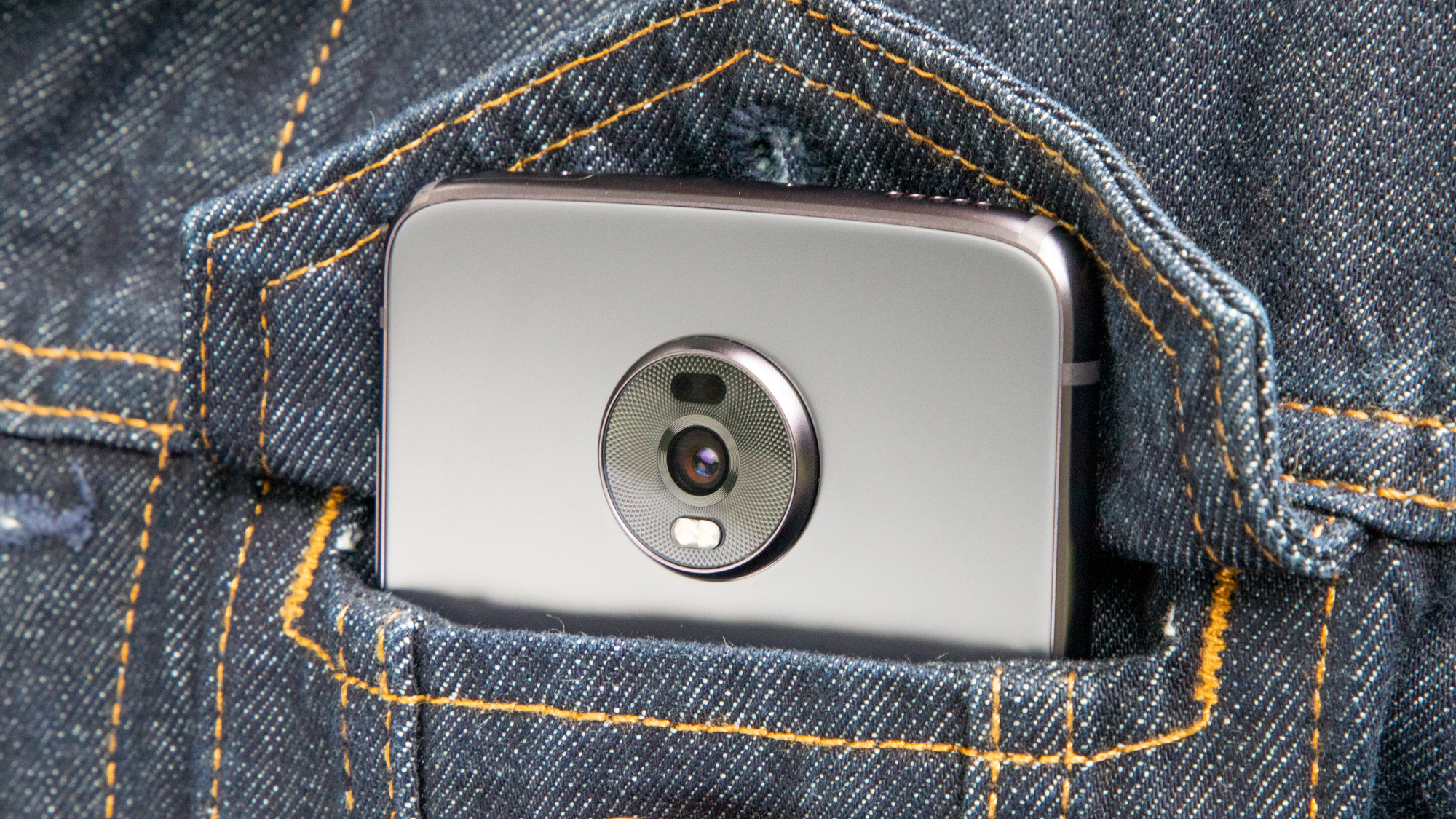
Camera
The Moto Z4 has two cameras - one in back, and one in front. While many flagship phones have upped their camera game by adding lenses, the Moto Z4 has reduced its total, ditching the twin-lens setup of the last few Z-line phones for a single 48MP rear shutter. And yet, the photos look...slightly better than in the Moto Z3.
Why? Software. Motorola is following the lead of the Google Pixel 3 by leaning on software to augment its single lens, leading to a more nuanced color palette and depth without needing another lens.
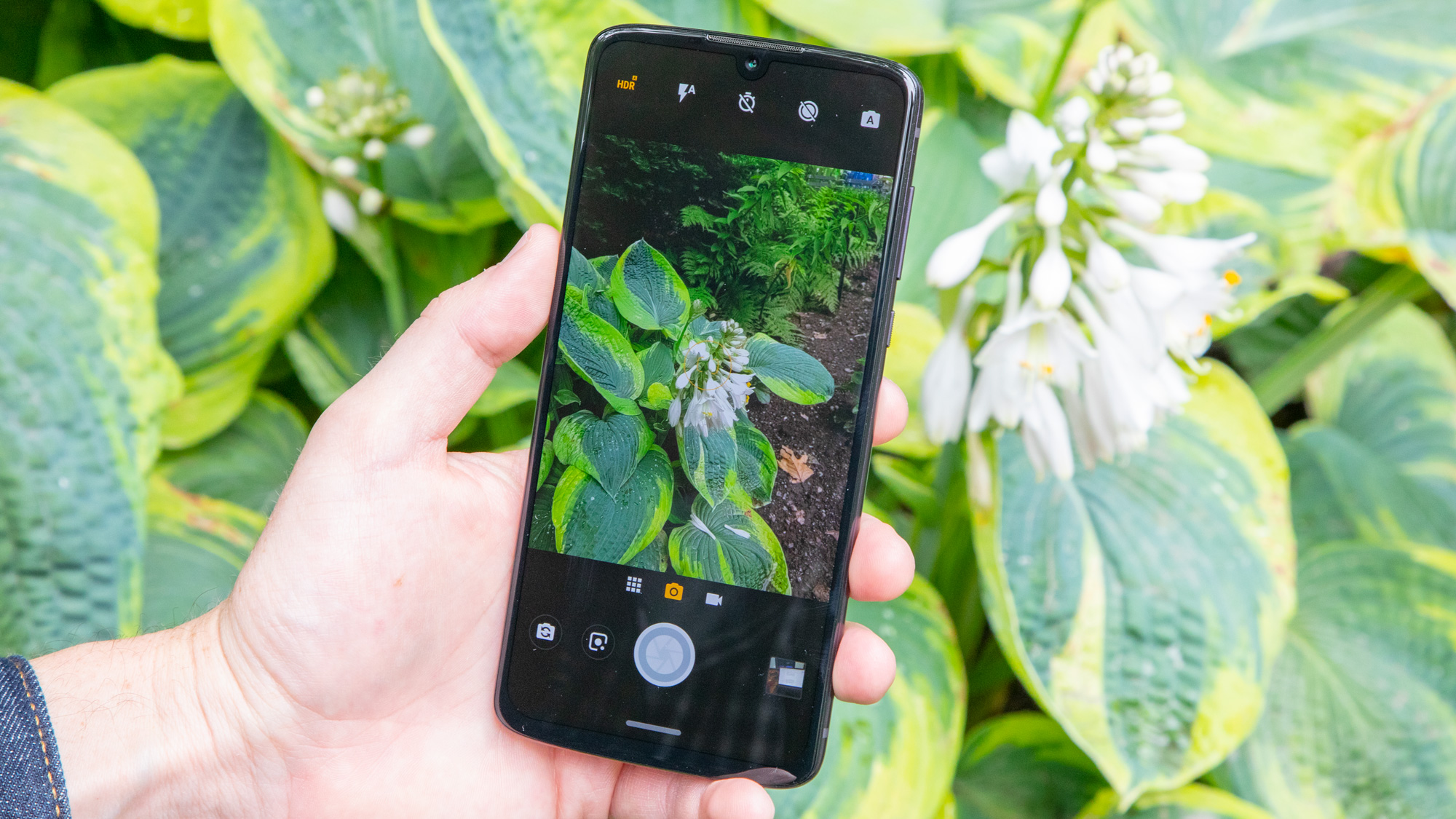
It doesn’t unseat the best camera phones we’ve tested; like most handsets, it struggles to reconcile lighting at different depths, resulting in slightly blown-out backgrounds or simply broad, white skies when it’s focused on foregrounds. But it manages to do a lot with a little, and its camera is superior to its predecessor’s.
That’s especially true in low-light settings - bars, interiors, etc - where the camera does better than expected, though nighttime shots look artificially brightened with lots of noise. More frustrating still, we couldn’t find the dedicated Night Vision mode - and per these forum discussions, we weren’t the only one struggling to get the right software updates for it to appear.
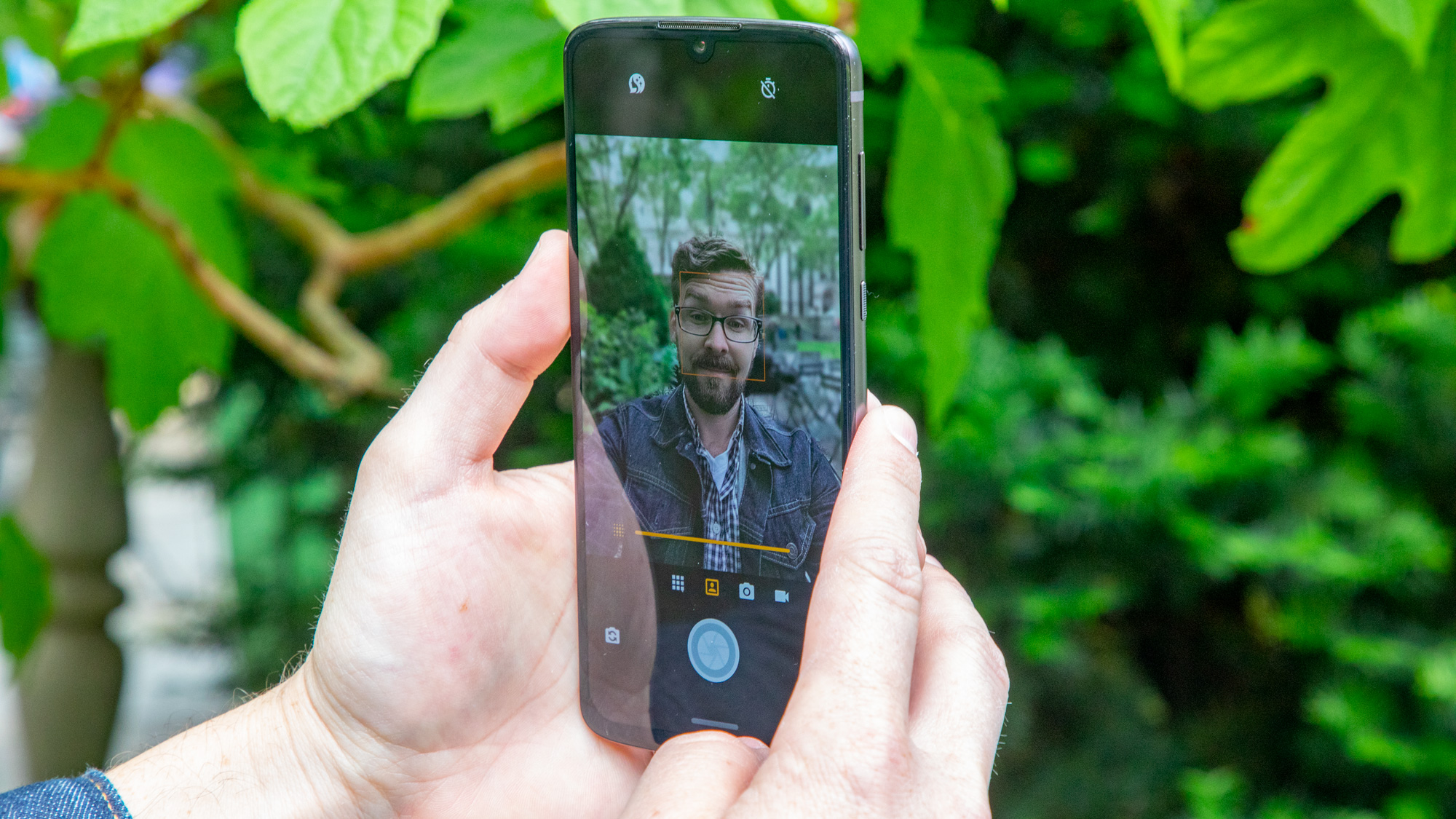
The front-facing 25MP camera is an upgrade over the 8MP shooter that’s been in the Z-series for awhile. It’s better, capturing more complex background lighting and making admirable use of software-powered depth.
Performance
Let’s get this out of the way first: it’s true that the Moto Z4’s Snapdragon 675 isn’t a flagship chip, and it might be less powerful than the older Snapdragon 835 in its predecessor, the Moto Z3. In our tests, the Z4 scored a 6,523 on an averaged Geekbench 4 CPU test, while the Z3 had previously hit a 6,549 on the same.
But you won’t notice lower performance, or any sort of slowdown, while running through your daily routine (at least from what we saw). The only noticeable lag was in loading streaming media - a show on Netflix - and only by a second in a side-by-side comparison with an iPhone XS Max.
The 4GB of RAM - which is the only option this time around - seems low in 2019, though we didn’t experience any hang-ups that indicated Motorola was being stingy with its techy innards. Not that RAM is required for high performance, as Apple’s iPhones haven’t needed to overinvest in the stuff to maintain their high performance. It’s just that this phone won’t be as future-proofed as others out there.
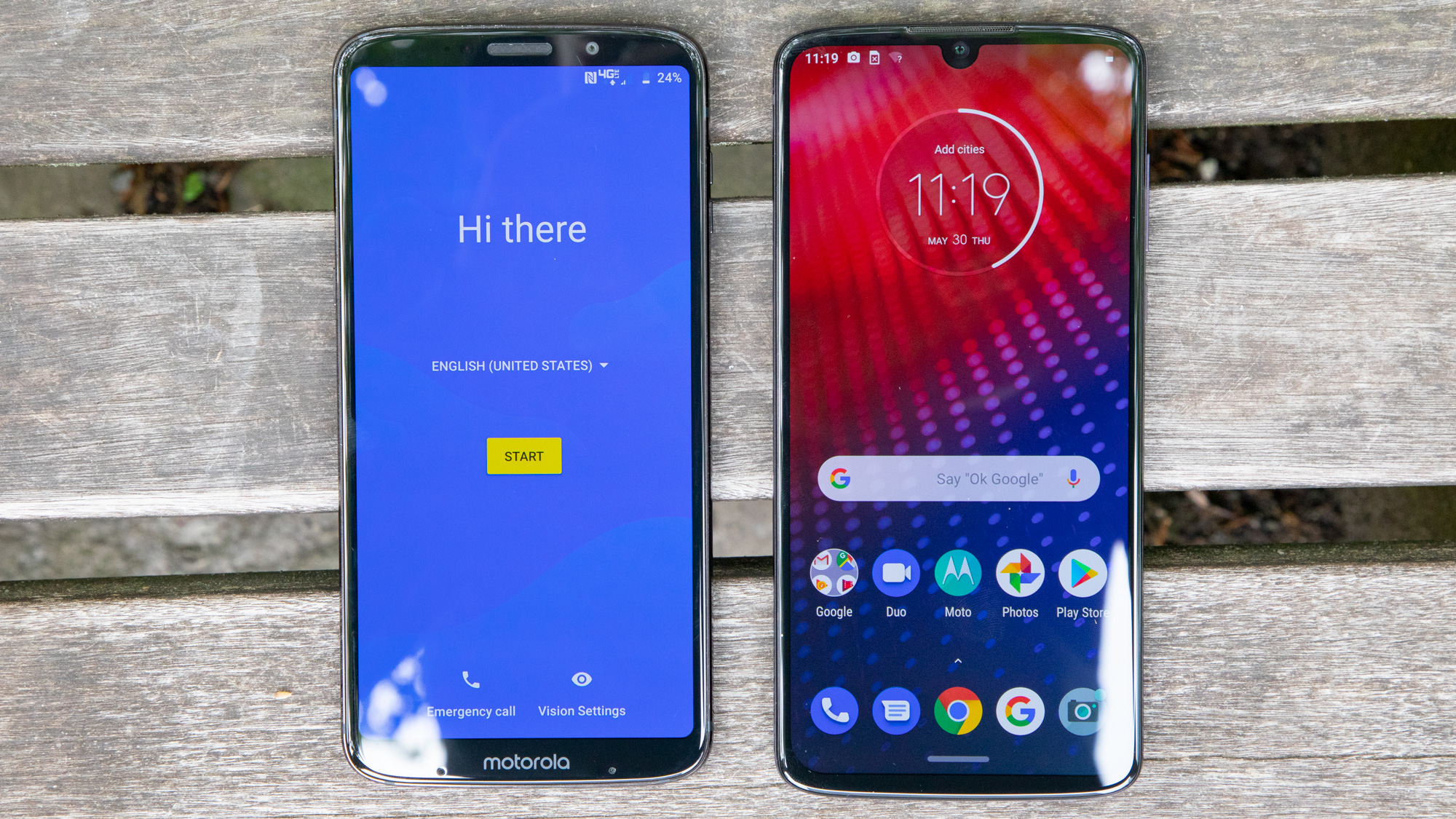
Software
The Moto Z4 comes with Android Pie out of the box, though that won’t be the latest and greatest OS for long with Android Q expected to be released in August.
While Moto phones aren’t the first to update to the new version of Android - it took eight months for the Moto Z3 phones on Verizon to upgrade to Android Pie, curiously, per XDA Developers - it’s still sooner than other phones.
Fortunately, Motorola has followed precedent with its treatment of Android Pie, with minimal tweaks and a handful of additional apps. The latter includes Moto Actions, which are beloved by Moto fans for a reason: while some are more useful than others, a handful of options are darn near perfect, like the ‘double chop’ that turns on the flashlight or the One Button Nav replacing the traditional triple-button Android setup for a single horizontal bar that should be easier for most thumbs to swipe around.
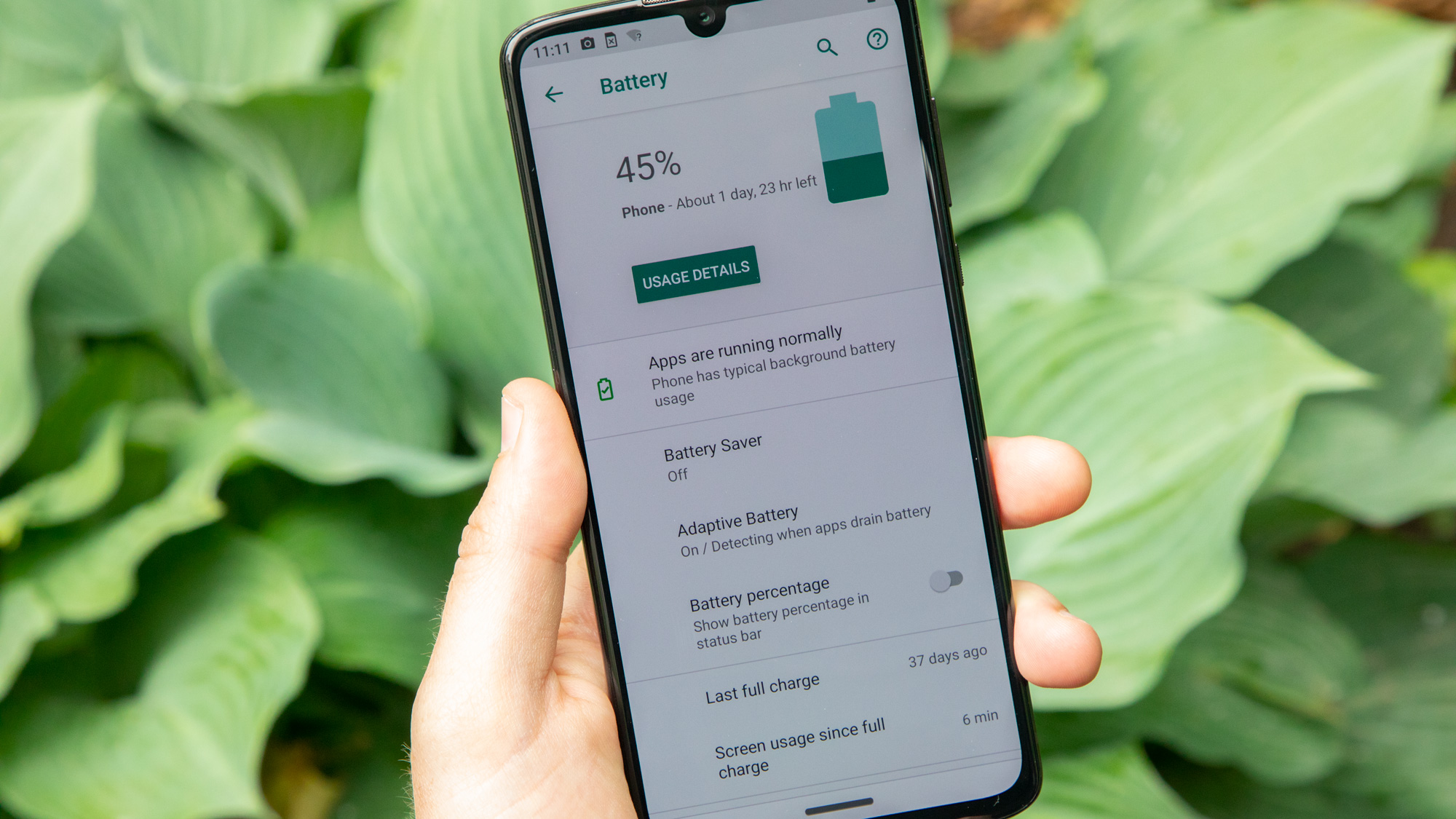
Battery
Another noticeable improvement the Moto Z4 packs over its predecessor is its 3,600mAh battery, up from the Z3’s 3,000mAh capacity. The increase isn’t quite noticeable, though the Z4 will certainly last through a day of regular use.
But if you need more - well, that’s what the Moto Mods are for. As stated in the previous section, plenty of Mods pack in extra battery potential, while the Power Pack itself is a near-necessity to push your phone past two days of use if you’re careful, though it does add 72g (half again as much as the Z4 weighs) to your handset.
Sadly, you’ll have to rely on a USB-C cable or Mods to power your phone: the Moto Z4 doesn’t have wireless charging. (Though it does support up to 15W fast charging with the included Turbo Charger.)

Who’s it for
You want 5G and you want it cheap
If you’re dead-set on harnessing 5G and don’t mind its multitudinuous limitations, you should pick up a Moto Z4 - but only if you live in a city that Verizon’s already opened up 5G service in.
You need a decent midrange phone
For years, Moto Z-line phones were reliable midrange-and-above choices for Verizon subscribers - and the Moto Z4 doesn’t ruin that streak. It won’t impress anyone, but it won’t disappoint, either.
You’re into Moto Mods
Sadly, Motorola didn’t introduce any new Mods, but if you enjoy the existing suite of add-ons to kit out your phone for new uses - like being a portable boombox or subbing as a new Alexa speaker - this is a good option (unless you want to pick up a cheaper Moto Z3…).
Who’s it not for
You want a cutting-edge phone with all the new bells and whistles
The Moto Z4 is not a flagship phone, and thus doesn’t pack all of this year’s cool new advances like, say, reverse wireless charging (heck, it can’t even charge wirelessly itself).
You want a phone camera powerhouse
The Moto Z4 has higher-megapixel cameras than its predecessor, but the software it’s using to augment its shots aren’t nearly the pair of photo powerhouses like the Google Pixel 3a handsets.
You want a serious budget phone
The Moto Z4 is priced solidly in the midrange tier, but if you wanted a budget phone with a minimal power dip, you really don’t have to look far - check out Motorola’s own Moto G7.
Competition

Google Pixel 3a
The Google Pixel 3a is the new king of midrange power phones with a Snapdragon 670, 4GB of RAM, a 3.5mm headphone jack and, of course, the signature Google Pixel camera prowess. It captures nearly the same photos as the flagship Google Pixel 3 at half the price.
In fact, the Pixel 3a is even cheaper than the Moto Z4 with a pricetag of $399 / £399 / AU$649. It's hard not to recommend this phone over Motorola's latest phone - though of course, Google's midrange champion can't hook up to 5G or use Moto Mods, if that swings the needle for you.
Want a phone that costs even less? Here's our list of best cheap phones
David is now a mobile reporter at Cnet. Formerly Mobile Editor, US for TechRadar, he covered phones, tablets, and wearables. He still thinks the iPhone 4 is the best-looking smartphone ever made. He's most interested in technology, gaming and culture – and where they overlap and change our lives. His current beat explores how our on-the-go existence is affected by new gadgets, carrier coverage expansions, and corporate strategy shifts.
